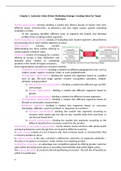Chapter 1: Customer Value-Driven Marketing Strategy: Creating Value for Target
Customers
Market segmentation involves dividing a market into distinct groups of buyers who have
different needs, characteristics, or behaviors and who might require septate marketing
strategies or mixes.
the company identifies different ways to segment the market and develops
profiles of the resulting market segments.
Market targeting (or targeting) consists of evaluating each market segment’s attractiveness
and selecting one or more market segments to enter.
Differentiation involves actually
differentiating the firms market offering to
create superior customer value.
Positioning consists of arranging for a market
offering to occupy a clear, distinctive, and
desirable place relative to competing
Figure 1: Designing a Customer-Driven Marketing Strategy
products in the minds of target consumers.
Some segmentation variables for consumer markets:
- Geographic segmentation: dividing a market into different geographical units, such as
nations, states, regions, countries, cities, or even neighborhoods.
- Demographic segmentation: dividing the market into segments based on variables
such as age, life-cycle stage, gender, income, occupation, education, religion,
ethnicity, and generation.
1) Age and life-cycle segmentation: dividing a market into different age and life-
cycle groups.
2) Gender segmentation: dividing a market into different segments based on
gender.
3) Income segmentation: dividing a market into different income segments.
- Psychographic segmentation: dividing a market into different segments based on
lifestyle or personality characteristics.
- Behavioral segments: dividing a market into segments based on consumer
knowledge, attitudes, used of a product, or responses to a product.
1) Occasion segmentation: dividing the market into segments according to
occasion when buyers get the idea to buy, actually make their purchase, or
use the purchased item.
2) Benefit segmentation: dividing the market into segments according to the
different benefits that consumers seek from the product.
Intermarket (cross-market) segmentation can be used to reach customers with similar needs
and buying behaviors even though they are located in different countries.
A target market consists of a set of buyers who share common needs or characteristics that
a company decides to serve.
A product position is the way a product is defined by customers on important attributes –
the place it occupies in consumers’ minds relative to competing product.
Competitive advantage: an advantage over competitors gained by offering greater customer
value either by having lower prices or providing more benefits that justify higher prices.
The value proposition of a brand is the full positioning of a brand – the full mix of benefits on
which it is positioned.
1
, A positioning statement is a statement that summarizes company or brand positioning using
this form: To (target segment and need) our (brand) is (concepts) that (point of difference).
Figure 2: Market-Targeting Strategies
A market-coverage A market coverage A market-coverage Micromarketing: tailoring
strategy in which a firm strategy in which a firm strategy in which a firm products and marketing
decides to ignore market targets several market goes after a large share of programs to the needs
segments differences and segments and designs one or a few segments or and wants of specific
go after the whole market separate offers for each. niches. individuals and local
with one offer. customer segments
Local marketing: tailoring brands and marketing to the
needs and wants of local customer segments – cities,
neighborhoods, and even specific stores. Individual marketing:
tailoring products and
marketing programs to
the needs and
preferences of individual
customers.
2
, Chapter 2: Engaging Consumers and Communicating Customer Value Integrated Marketing
Communication Strategy
A company’s total promotion mix – also called its marketing communications mix – consists
of the specific blend of advertising, public relations, personal selling, sales promotion, and
direct marketing tools that the company uses to engage consumers, persuasively
communicate customer value, and build customer value; there are five major tools:
- Advertising: any paid form of nonpersonal presentation and promotion of ideas,
goods, or services by an identified sponsor.
- Sales promotion: short-term incentives to encourage the purchase or sale of a
product or service.
- Personal selling: personal customer interactions by the firm’s sales force for the
purpose of engaging customers, making sales, and building customer relationships.
- Public relations (PR): building good relations with the company’s various publics by
obtaining favorable publicity, building up a good corporate image, and handling or
heading off unfavorable rumors, stories, and events.
- Direct and digital marketing: engaging directly with carefully targeted individual
consumers and customer communities to both obtain an immediate response and
build lasting customer relationships.
Content marketing: creating, inspiring and sharing brand messages and conversations with
and among consumers across a fluid mix of paid, owned, earned, and shared channels.
Integrated marketing communications (IMC) is defined as carefully integrating and
coordinating the company’s many communications channels to deliver a clear, consistent,
and compelling message about the organization and its products.
The buyer-readiness stages are the stages consumers normally pass through on their way to
a purchase.
Figure 3: Buyer-Readiness Stages
In personal communication channels, two or more people communicate directly with each
other; they might communicate face-to-face, on the phone, via (e)mail, or even through
texting or an internet chat.
- Word-of-mouth influence: the impact of the personal words and recommendations
of trusted friends, family, associates, and other consumers on buying behavior.
- Buzz marketing: cultivating opinion leaders and getting them to spread information
about a product or a service to others in their communities.
Nonpersonal communication channels: media that carry messages without personal contact
or feedback, including major media, atmospheres and events.
Four common methods used to set the total budget for advertising:
1) Affordable method: setting the promotion budget at the level management thinks
the company can afford.
2) Percentage-of-sales method: setting the promotion budget at a certain percentage of
current or forecasted sales or as a percentage of the unit sales price.
3) Competitive-party method: setting the promotion budget to match competitors’
outlays.
3





